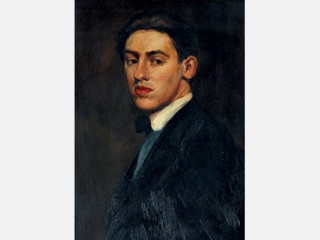
Charles Demuth biography
Date of birth : 1883-11-08
Date of death : 1935-10-25
Birthplace : Lancaster, Pennsylvania, U.S.
Nationality : American
Category : Famous Figures
Last modified : 2011-02-09
Credited as : Artist painter, intimate watercolors and geometrized urban scenes, I Saw the Figure 5 in Gold
American painter Charles Demuth, distinguished for intimate watercolors and geometrized urban scenes, was one of the leading artists of precisionism, an American idiom of cubism in the 1920s.
Charles Demuth was born in Lancaster, Pa., on Nov. 8, 1883. A childhood leg injury left him lame, and at an early age he began to draw and paint. After studying at the School of Industrial Art in Philadelphia, he entered the Pennsylvania Academy of Fine Arts in 1905 and took classes with William Merritt Chase and Thomas Anschutz.
In 1907 Demuth went to Paris, where Fauve painting with its expressive form and color affected his early work. Studio Interior (ca. 1907), one of the few surviving works of this period, is a watercolor whose roughly outlined, loosely painted figures are reminiscent of those of Henri Matisse and Georges Rouault. It foreshadows the illustrational style Demuth employed, in refined form, later. He continued his studies at the Pennsylvania Academy (1908-1910), and his interest in figure drawing increased. As he refined his focus, the personages depicted became vehicles for acute psychological expression. In Paris again in 1912, he attended classes at the academies Julian, Colarossi, and Moderne. One of the few American artists of the period with firsthand understanding of the new European movements of cubism and Dada, Demuth evolved an art that transcended their literal and localized themes. In fact, he always remained receptive to a wide range of influences, and various styles found intelligent transmutation in his work.
Demuth's early watercolors, shown at the Pennsylvania Academy in 1912 and 1913, revealed a fragile, understated style; his landscapes, executed in delicate washes, evoked a gamut of European associations. Fauve references remained, but a new ***concern with formalism was evident, and there are parallels to Paul Cezanne's prismatic vistas in such paintings as New Hope, Pennsylvania (1911/1912). But even when Demuth employed the analytic approach of Cezanne or the cubist planes of Pablo Picasso, his art remained concerned with surface quality, not internal structure.
By 1915 Demuth was established as a major American artist through his landscapes, flower studies, and smallscale paintings of cabaret and circus performers. His figures have a weightless and phantomlike quality; in Two Acrobats (1918), entertainers dressed in tuxedoes float surrealistically through a vague landscape. Demuth's sensitive linear style was eminently suited to illustrating plays and novels such as Ãmile Zola's Nana, Henry James's The Turn of the Screw, Frank Wedekind's Pandora's Box, and Edgar Allan Poe's The Mask of the Red Death. These illustrations, not meant for publication, reflect Demuth's taste for the psychologically distorted and depict sexual conflict and social decadence.
In White Architecture (1917) Demuth used the cubist technique with delicacy and individuality and employed color sparingly to modify a complex of overlaid and intersecting structural planes derived from the building itself. He developed this style in his paintings of factories and industrial sites, beginning in 1918, and thus was a pioneer of the precisionist movement.
Demuth did a unique group of "poster portraits" (symbolic still-life paintings) that reflected the interests and attributes of friends, including painters Georgia O'Keeffe, Marsden Hartley, and Arthur Dove and poet William Carlos Williams. The best-known of these, I Saw the Figure 5 in Gold (1928), a "portrait" of Williams, whose title derives from a Williams poem, is a direct ancestor of pop art, using the numeral 5 in a repeated abstract arrangement. Demuth died in Lancaster on Oct. 25, 1935.
















